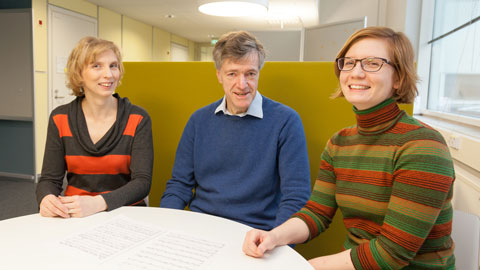Eye Movements Tell a Tale of Musical Skills
What is skilful music reading? Postdoctoral Research Fellow Marjaana Puurtinen at Turku Institute for Advanced Studies is investigating the topic by tracking eye movement. Her research is part of a consortium project of the Universities of Turku and Jyväskylä funded by the Academy of Finland.

Tarja-Riitta Hurme (vas.), Hans Gruber and Marjaana Puurtinen form the Turku team of the Academy-funded consortium. Postdoctoral Research Fellow at Turku Institute for Advanced Studies (TIAS) Marjaana Puurtinen says that even though an outsider can easily think that the project is all about music, in the end it is about people. – The interest lies in how humans can learn such a complicated skill, says Puurtinen.
Postdoctoral Research Fellow Marjaana Puurtinen has a goal. She wants to find out how a skilled reader operates by studying the eye movements of people reading music.
As an educationalist, Puurtinen is interested in how to learn and, above all, hot to teach more effectively.
Her research for the doctoral dissertation, which she conducted while her name was still Penttinen, revealed that the eyes of a musician reading music while playing an instrument is fixed on a more narrow part of the notation than previously thought.
– During my dissertation project, we developed measurements which I can now utilise in my research. I am enriching and extending my dissertation project. Among other things, my goal is to find answers for how a skilled music reader operates and how the readers develop, describes Puurtinen.
The research subjects include music students as well as teacher students who are only just learning how to play.
– We can learn from the musician who can already read notation. With the students who cannot yet read notation, we will be able to see how the music reading skill develops. When we can refute myths about the musical skills with the knowledge gained from the research, we can improve the way we teach the reading of music, says Puurtinen.
Eye Movements Reveal the Difficulty of the Symbols
Even before the research on reading notations, eye movement was tracked in the reading of ordinary texts. As an international "language", music opens up new possibilities into culture specific reading, which is why the co-operation between the Faculty of Education of the University of Turku and Visiting Professor Hans Gruber from the University of Regensburg can reveal new information.
– The eye tracking camera gives us hints, for example, which symbols are easy to read and which ones are more difficult. One of our goals is to find out what kind of elements create a complex notation, says Puurtinen.
Multidisciplinary Consortium
In addition to the Department of Teacher Education of the University of Turku, the Department of Music of the University of Jyväskylä is part of the consortium. In Turku, Senior Research Fellow Tarja-Ritta Hurme and Professor Gruber are working in the Reading Music: Eye-movements and the Development of Expertise research project alongside Puurtinen. The consortium is led by Professor Erkki Huovinen from the Department of Music of the University of Jyväskylä. At Jyväskylä, the research consortium also includes Musicologist Nina Loimusalo and Statistician Anna-Kaisa Ylitalo.
– Therefore our research involves cognitive musicology, education and statistics, says Puurtinen.
She wishes to remind everyone that also others than professional and amateur musicians need music reading skills, such as the music librarians who use notations as a source of information.
– The aim of the project is to produce a book to as wide an audience as possible, from music educators to amateurs and professionals.
Text: Erja Hyytiäinen
Photos: Antti Tarponen
Translation: Mari Ratia